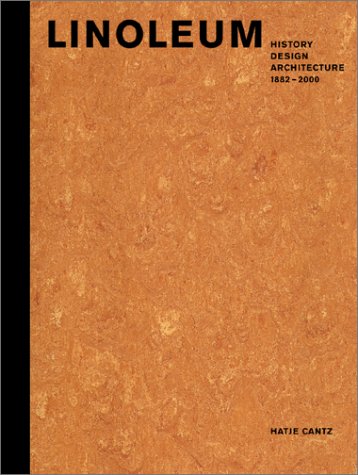Verwandte Artikel zu Linoleum history design architecture: history, design,...

Inhaltsangabe
This text presents linoleum in its various guises. It looks at the historical and ecological importance of this material. The essays are contributed by experts and cover the history of linoleum, its "discovery" by modernist designers and architects and its renaissance in contemporary design.
Die Inhaltsangabe kann sich auf eine andere Ausgabe dieses Titels beziehen.
Reseña del editor
What is the secret connection between linoleum and the 20th century avant-garde? What would the homes of the Bauhaus designers and other modernists be without it? This new publication explores the eventful and fascinating history of this ubiquitous but overlooked material that has stood under the feet of many an artist, at one point or another, over the past century. Invented in 1864 by the British entrepreneur Frederik Walton, linoleum's first golden age was between 1900 and 1930, when countless renowned designers--among them Josef Hoffmann and Bruno Paul--used the natural material in their collections and patterns, and even Peter Behrens tried his hand at designing linoleum patterns. And such Bauhaus architects as Mies van der Rohe and Bruno Taut used linoleum in their housing designs as an inexpensive, sturdy, and of course decorative floor covering. Linoleum: History, Design, Architecture is the first book to present this historically and ecologically important material in all of its various guises over the past one hundred-plus years. Experts on design and architecture contribute essays on linoleum's history, its ''discovery'' by modernist designers and architects and its renaissance in contemporary design and architecture.
„Über diesen Titel“ kann sich auf eine andere Ausgabe dieses Titels beziehen.
Gratis für den Versand innerhalb von/der USA
Versandziele, Kosten & DauerSuchergebnisse für Linoleum history design architecture: history, design,...
Linoleum : History, Design, Architecture 1882-2000
Anbieter: Better World Books, Mishawaka, IN, USA
Zustand: Very Good. Used book that is in excellent condition. May show signs of wear or have minor defects. Artikel-Nr. 53310926-6
Anzahl: 1 verfügbar
Linoleum history design architecture: history, design, architecture 1882-2000
Anbieter: Thomas Emig, Altlandsberg, Deutschland
Hardcover. Zustand: Wie neu. Ohne Schutzumschlag. 1. Auflage. 251 pages with many coloured illustrations. Artikel-Nr. 2024-019385
Anzahl: 1 verfügbar
Linoleum: History, Design, Architecture - 1882-2000
Anbieter: Versandantiquariat Cornelius Lange, Würzburg, Deutschland
Hardcover. Zustand: deutliche Gebrauchspuren. 252 S. Groß-4°. Einband leicht bestoßen sowie mit Rand- und Eckläsuren. Ecken teilweise stärker angeplatzt. Innen sauber. Artikel-Nr. BN9031
Anzahl: 1 verfügbar
Linoleum - History, Design, Architecture 1882 - 2000
Anbieter: Celler Versandantiquariat, Eicklingen, Deutschland
Hatje Cantz Publishers, Ostfildern-Ruit, 2001. 251 Seiten mit vielen Abbildungen, Pappband, quart---- gutes Exemplar / good condition / English translation: Ingrid Nina Bell / Text englisch - 1350 Gramm. Artikel-Nr. 2j13413
Anzahl: 1 verfügbar
Linoleum, History, Design, Architecture 1882-2000; Linoleum, Geschichte, Design, Architektur 1882-2000, engl. Ausg.
Anbieter: medimops, Berlin, Deutschland
Zustand: very good. Gut/Very good: Buch bzw. Schutzumschlag mit wenigen Gebrauchsspuren an Einband, Schutzumschlag oder Seiten. / Describes a book or dust jacket that does show some signs of wear on either the binding, dust jacket or pages. Artikel-Nr. M03775709908-V
Anzahl: 2 verfügbar
Linoleum, History, Design, Architecture 1882-2000; Linoleum, Geschichte, Design, Architektur 1882-2000, engl. Ausg.
Anbieter: medimops, Berlin, Deutschland
Zustand: as new. Wie neu/Like new. Artikel-Nr. M03775709908-N
Anzahl: 1 verfügbar
Linoleum
Anbieter: Bookbot, Prague, Tschechien
Hardcover. Zustand: As New. What is the secret connection between linoleum and the 20th century avant-garde? What would the homes of the Bauhaus designers and other modernists be without it? This new publication explores the eventful and fascinating history of this ubiquitous but overlooked material that has stood under the feet of many an artist, at one point or another, over the past century. Invented in 1864 by the British entrepreneur Frederik Walton, linoleum's first golden age was between 1900 and 1930, when countless renowned designers--among them Josef Hoffmann and Bruno Paul--used the natural material in their collections and patterns, and even Peter Behrens tried his hand at designing linoleum patterns. And such Bauhaus architects as Mies van der Rohe and Bruno Taut used linoleum in their housing designs as an inexpensive, sturdy, and of course decorative floor covering. History, Design, Architecture is the first book to present this historically and ecologically important material in all of its various guises over the past one hundred-plus years. Experts on design and architecture contribute essays on linoleum's history, its ''discovery'' by modernist designers and architects and its renaissance in contemporary design and architecture. Artikel-Nr. 4fb9112b-62c6-4990-a269-aea85b2c399b
Anzahl: 1 verfügbar
